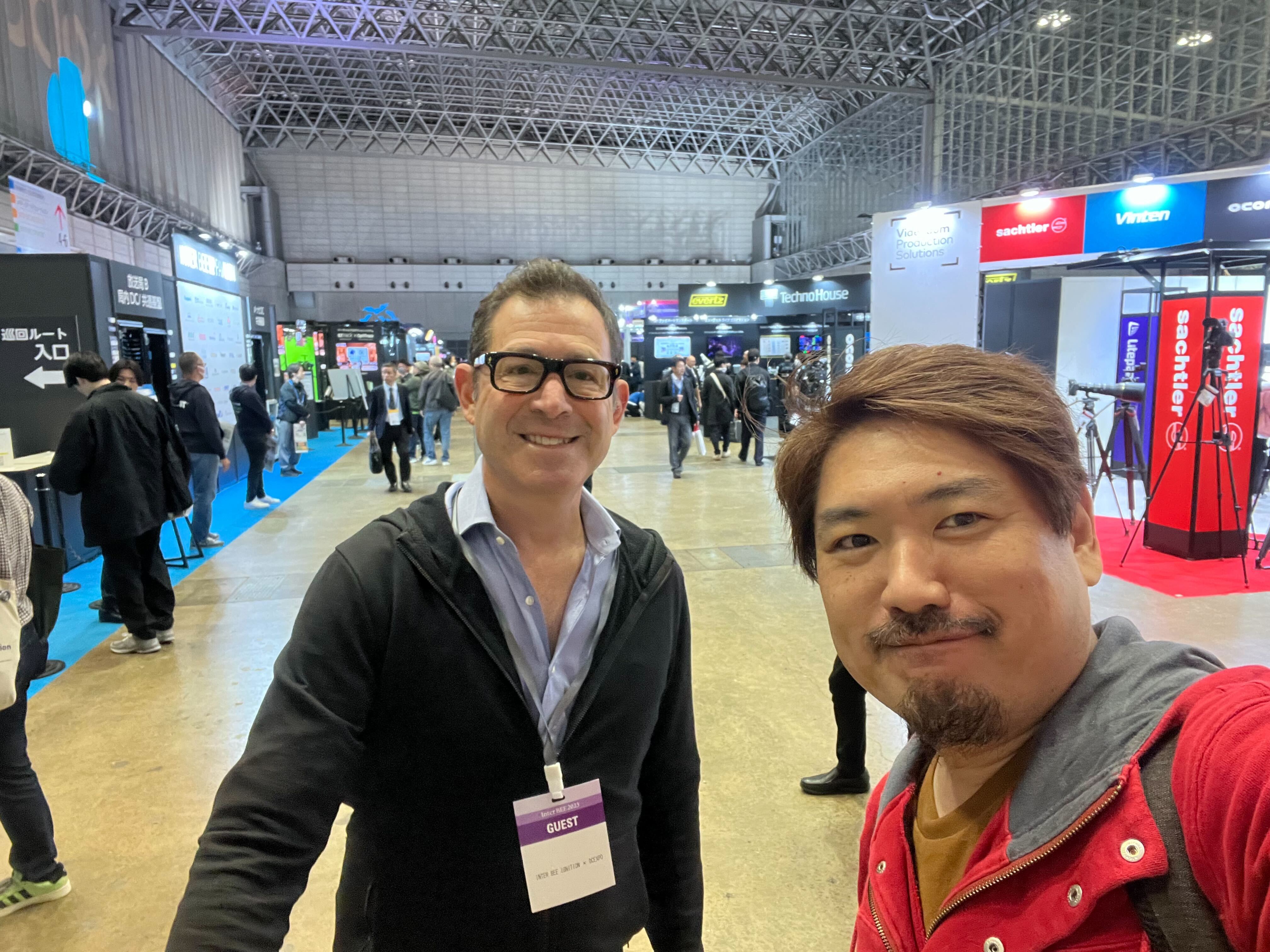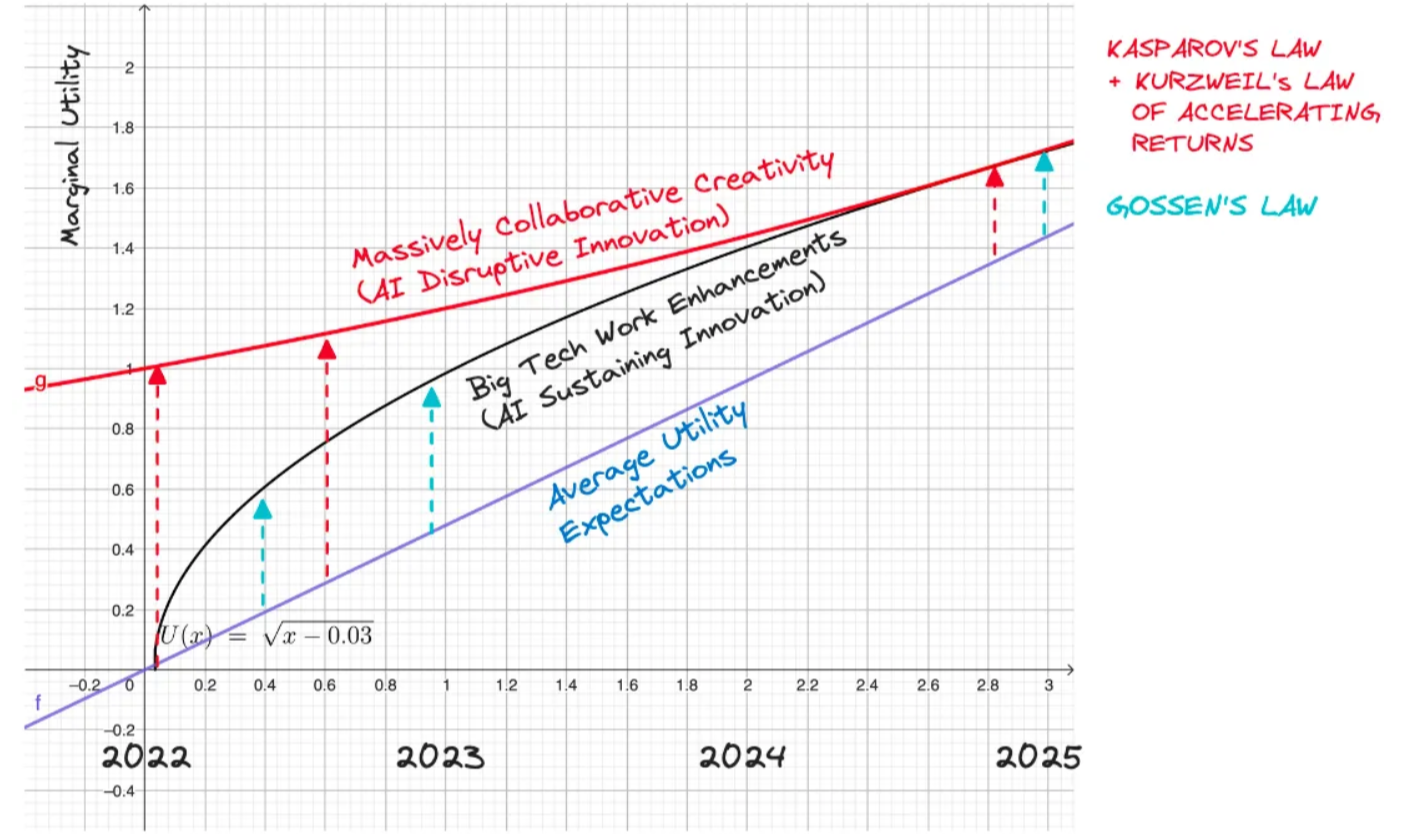Here is a contribution from Scott Broock, a long-time contributor to the generative AI and visual entertainment industry in Los Angeles. It is a feedback for stage in DCEXPO2023.

The View on AI From Japan in Four Graphs

When ChatGPT arrived last November, it immediately caught fire with early adopters. Its creative utility was through the roof due to the simplicity of its interface and uncanny ability to mimic human intelligence. But it’s far more than just a chatbot. It is a revolutionary toy for massively collaborative creativity that increases your intelligence the more you use it.
Which is why Los Angeles and Tokyo are now the epicenters of a paradigm shift in global entertainment.
As Chris Dixon of A16Z has famously stated, the next big thing always starts off as a toy. Additionally, he has observed that new core technologies historically arrive as pairs: a strong form and a weak form.
As you’ll see below, the view from Japan is that the strong form of the Singularity has already arrived. According to Professor Akihiko Shirai, we were just too distracted to notice.
The four graphs in this note are an adaption and expansion on Shirai-san’s presentation last week at InterBEE2023, the NAB of Japan.
Let’s start with a close-up of today’s market.
In Figure 1 above, the top red line represents the marginal utility of ChatGPT as a disruptive toy. As Sam Altman has explained, hallucinations are more like a feature than a bug when it comes to generative AI. Indeed, the more intelligently that you play with it, the more entertaining it becomes. As we’ve discussed elsewhere, the disruptive innovation at play here is its use for “massively collaborative creativity,” also known as bricolage. It is inherently symbolic, non-linear, and multi-sensory. Which are the properties of an entirely new medium in which AI is a constant companion for life. AI from this vantage point is not “artificial intelligence,” but animated intelligence.
The middle curved black line is the marginal utility of ChatGPT as a work assistant, or copilot. These are safe, sustaining, incremental applications of the technology by incumbents that will start out looking exponential in potential total marginal utility, but begin to taper off over time. This is an adaptation of Gossen’s first law of diminishing marginal utility. Overly simplified, Gossen’s first law can be explained with a plate of cookies. If you haven’t eaten all day, the first cookie is going to deliver high marginal utility — pleasure and enjoyment. The next cookie will be equally delicious, but not as satisfying as the first. Keep on eating and eventually your marginal utility will decrease until you are satiated. From that point forward, your marginal utility will be negative. In the context of ChatGPT, there is a ceiling on the marginal utility of Transformers for linear thinking that will become apparent as time marches on.
The bottom straight blue line is the linear growth in marginal utility generally expected from technology each year. It is a hypothetical baseline and not one that you would observe in nature.
If we look at Figure 1 on the compressed time scale of three years from the launch of ChatGPT in November 2022, projected through to 2025, the marginal utility from massively collaborative will appear to be shrinking over time. You might interpret this as an inevitable global chill of expectations that brings both sides down towards “normal.” As we will see below, this short-term view hides the effects of Kasparov’s Law, which makes the red line highly potent and exponential as we pull back to reveal more time.
Kasparov’s Law roughly states that a “weak human” (Kasparov’s term) using even average AI in a good process (disruptive strategic play) will always beat a powerful opponent using AI in a bad process (sterile but safe play). Kasparov calls these winning weak human-AI hybrids “Centaurs.”

As we pull back in Figure 2 to reveal more of the timeline, we see that the marginal utility of massively collaborative creativity has in fact been growing exponentially as the strong form, never dipping below the linear baseline. The black line of the sustaining use eventually dips below the linear baseline, as the sustaining use delivers shallower growth over time. It is the weak form.
For additional reference, a hypothetical orange line has been added to show the projected declining marginal utility of legacy linear media as it reaches full commodity satiation. Marvel’s MCU comes readily to mind, but it is by no means the only example.
One could also place a marker on 2025 as a year of significance in key Asian markets for low-latency 5G “Core” services and early sensory 6G trials. This merits another layer of discussion about holographic media that is best served in a separate note.

As we pull further out in Figure 3, we find that the exponential growth in the marginal utility of massively collaborative creativity becomes manifest, and the diminishing returns of the sustaining weak use pronounced.

Finally, in Figure 4, we reach a time scale that matches Ray Kurzweil’s prediction of the AI Singularity by 2045. From this futuristic viewpoint, we see the full extent of the revolution that has already occurred.
The critical point is that AI’s marginal utility as an intelligent, entertaining, and non-linear toy right now is its biggest strength and best framing.
Even if the payoff seems small in the short run, iteratively investing and incrementing your time in massively collaborative creativity over the next few years will accelerate your climb up the slope of accelerating marginal returns.
In the playful words of Shirai-san, “Enjoy your toys.”
Stay tuned for news on the next LA and Tokyo Salons in the new year. I’m also pleased to share Shirai-san’s news that the Tokyo AI Festival is March 23rd and 24th, 2024. It promises to be a transformative event.
> [my official translation] Simply because it was dark while society was going through the long tunnel, there was no sense of experience. There was "Oh, it's a passing station," and no view in the dark train window going backwards, and the world changes. As you only see the world inside your house because of the Covid.
Although the difference now appears to be only a small one, the important attitude to keep up with this exponential change in streamlines is to have fun, become a player by working with your own hands, and develop yourself even by a factor of 1.1 over the previous year. This can create a huge gap that you will never be able to keep up with even if you continue to invest linearly later on. If you miss a train and take the next one, you will never get to the same station. Enjoy your toys.



Comments